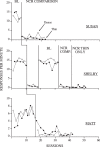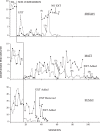Noncontingent reinforcement: a further examination of schedule effects during treatment
- PMID: 23322927
- PMCID: PMC3545495
- DOI: 10.1901/jaba.2012.45-709
Noncontingent reinforcement: a further examination of schedule effects during treatment
Abstract
We conducted 2 studies to determine whether dense and thin NCR schedules exert different influences over behavior and whether these influences change as dense schedules are thinned. In Study 1, we observed that thin as well as dense NCR schedules effectively decreased problem behavior exhibited by 3 individuals. In Study 2, we compared the effects of 2 NCR schedules in multielement designs, one with and the other without an extinction (EXT) component, while both schedules were thinned. Problem behavior remained low as the NCR schedule with EXT was thinned, but either (a) did not decrease initially or (b) subsequently increased as the NCR schedule without EXT was thinned. These results suggest that dense schedules of NCR decrease behavior by altering its motivating operation but that extinction occurs as the NCR schedule is thinned. The benefits and limitations of using dense or thin NCR schedules are discussed.
Keywords: aggression; extinction; functional analysis; motivating operation; noncontingent reinforcement; schedule effects; self-injurious behavior.
Figures
Similar articles
-
Noncontingent reinforcement as treatment for severe problem behavior: some procedural variations.J Appl Behav Anal. 1997 Spring;30(1):127-36; quiz 136-7. doi: 10.1901/jaba.1997.30-127. J Appl Behav Anal. 1997. PMID: 9103988 Free PMC article.
-
Brief report: Signals enhance the suppressive effects of noncontingent reinforcement.J Autism Dev Disord. 2010 Mar;40(3):378-82. doi: 10.1007/s10803-009-0879-0. J Autism Dev Disord. 2010. PMID: 19777331
-
Noncontingent reinforcement: effects of satiation versus choice responding.Res Dev Disabil. 1999 Nov-Dec;20(6):411-27. doi: 10.1016/s0891-4222(99)00022-0. Res Dev Disabil. 1999. PMID: 10641251
-
Noncontingent reinforcement is an empirically supported treatment for problem behavior exhibited by individuals with developmental disabilities.Res Dev Disabil. 2009 Jan-Feb;30(1):44-57. doi: 10.1016/j.ridd.2008.03.002. Epub 2008 May 7. Res Dev Disabil. 2009. PMID: 18467073 Review.
-
A review of "noncontingent" reinforcement as treatment for the aberrant behavior of individuals with developmental disabilities.Res Dev Disabil. 2000 Sep-Oct;21(5):377-91. doi: 10.1016/s0891-4222(00)00050-0. Res Dev Disabil. 2000. PMID: 11100801 Review.
Cited by
-
Noncontingent reinforcement for the treatment of severe problem behavior: An analysis of 27 consecutive applications.J Appl Behav Anal. 2017 Apr;50(2):357-376. doi: 10.1002/jaba.376. Epub 2017 Feb 8. J Appl Behav Anal. 2017. PMID: 28177118 Free PMC article.
-
Approaches for Treating Multiply Controlled Problem Behavior.Behav Anal Pract. 2023 Sep 21;17(1):53-69. doi: 10.1007/s40617-023-00858-1. eCollection 2024 Mar. Behav Anal Pract. 2023. PMID: 38405283 Free PMC article. Review.
-
An Analysis of Feedback from a Behavior Analytic Perspective.Behav Anal. 2015 Jan 14;38(1):51-75. doi: 10.1007/s40614-014-0026-x. eCollection 2015 May. Behav Anal. 2015. PMID: 27606167 Free PMC article.
-
Using Principles from Applied Behaviour Analysis to Address an Undesired Behaviour: Functional Analysis and Treatment of Jumping Up in Companion Dogs.Animals (Basel). 2019 Dec 6;9(12):1091. doi: 10.3390/ani9121091. Animals (Basel). 2019. PMID: 31817670 Free PMC article.
-
Multiple Schedules Facilitate Rapid Noncontingent Reinforcement Schedule Thinning.Behav Anal Pract. 2022 Aug 23;16(1):185-193. doi: 10.1007/s40617-022-00709-5. eCollection 2023 Mar. Behav Anal Pract. 2022. PMID: 37006419 Free PMC article.
References
-
- Carr J. E, Severtson J. M, Lepper T. L. Noncontingent reinforcement as an empirically supported treatment for problem behavior exhibited by individuals with developmental disabilities. Research in Developmental Disabilities. (2009);30:44–57. doi:10.1016/j.ridd.2008.03.002. - PubMed
MeSH terms
LinkOut - more resources
Full Text Sources
Medical



